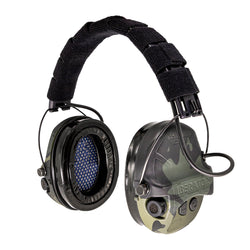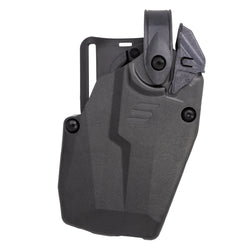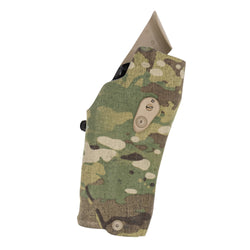Let’s say it’s the middle of the night, and your weather app just went off with an urgent message — Emergency Alert: Wildfire is spreading, be prepared to evacuate. You’re not known for being “prepared” for stuff like this and you don’t get in a hurry about much of anything.
You can hear sirens in the faint distance, and you notice, as you’re scrolling through social media that everyone is in a big rush.
Meanwhile, your neighbor, the guy you secretly refer to as “Doomsday Dave,” is already halfway to his bunker. He has a backpack slung over his shoulder and a determined look on his face. While you’re fumbling around trying to find your phone charger, he’s already kicked back on his bunk, munching on survival rations. He’s probably listening to a podcast about surviving the apocalypse, even though it’s a wildfire…

We all know someone like that right? Even the best of us feel a little like that guy when we’re in a hurry and not prepared. While a “bug-out bag” is often associated with those doomsday preppers, it’s not just for the zombie apocalypse. It’s for anyone who doesn’t want to be the last one scrambling when you-know-what hits the fan.
So call it an emergency bag if that makes you feel less dorky. But the point is, not being ready for an emergency is only asking for problems when an emergency takes place.
Let’s talk about why you need a bug-out bag, what you should pack, and how to make it just right for you.
Why You Need a Bug Out Bag
Let’s be honest, life doesn’t go as planned and sometimes bad things happen. One minute, you’re enjoying your favorite show on Netflix, and the next, the power goes out, and… well you get the point.
That’s when you realize you’ve got nothing ready — no emergency plan, no stash of essentials, nada. As you’re staring into the abyss of your empty pantry, you start to wonder why you never listened to your conspiracy theorist uncle. He’s been preaching about bug-out bags for years!
Whether it’s a natural disaster, civil unrest, or a surprise visit from your in-laws, you need a bug-out bag. Having a bag packed and ready to go could make all the difference, regardless of the type of emergency. And if you never need it, what does it hurt?

Most people who are involved in a large-scale emergency tell you they never thought it would happen to them. It’s easy to see that stuff on the news and assume it will always take place somewhere else. People who win the lottery feel the same way. You probably won’t win, but someone will.
Incidents may involve a natural disaster, rioting/civil unrest, a terrorist attack, or even an isolated incident related to you.
I once heard a police officer speak who was involved in a shooting. All the facts were not out yet, but an anti-police group leaked her address on the internet and a mob headed to her house. By the time she was warned, her and her family only had a few minutes to grab some items and run. If there were an emergency right now, can you be packed and ready to go in a few minutes? If not, you should consider setting up a bug-out bag.
What Should Be in Your Bug-Out Bag?
Alright, so if you decide it’s not a bad idea to have a bag ready to go, you may be wondering what to put in it. This does take some careful thought and planning. Filling your bag with snacks and video games probably won’t work. So, what do you need to survive?

This will depend on where you are going. And you should always have a plan for where you will go. Running off into the sunset to flee an emergency is better than nothing, but a pre-planned location works best. It also helps you understand what items are needed to get you there. Here’s a bug-out bag list to help you out.
Bug-Out bag basics
- Water: At least three days’ worth. You can’t survive without it, and no, soda doesn’t count.
- Food: Non-perishable items like energy bars, canned goods, and MREs (Meals Ready to Eat). Make sure it’s something you’d actually eat.
- Medical Kit: Basic first aid supplies, pain relievers, prescription medications, and a tourniquet.
- Money: Cards won’t work when the power’s out. Carry a mix of bills, and don’t forget some quarters.
- Map and Compass: Your phone’s GPS won’t do you any good if the battery is dead or the network is down. Knowing how to navigate the old-school way can save your life.
- Pre-assigned Locations: Have multiple locations designed for emergencies. If possible, choose locations in different directions so you have options.
- Self-Defense Firearm: A good handgun with ammo is great to keep in the bag. You can also take other firearms, but I like knowing I have one in the bag as well.
- Clothing: A change of clothes, including sturdy shoes, a jacket, gloves and a hat. You don’t want to be caught in the rain in your pajamas.
- Multi-tool: It’s like carrying a toolbox in your pocket. You’ll be amazed at how handy these things can be.
- Flashlight: Preferably one with extra batteries.
- Emergency Blanket
- Important Documents: Copies of IDs, insurance policies, and any other critical documents. Keep them in a waterproof bag.
- Personal Hygiene Items: Toothbrush, toothpaste, soap, and a small towel. Trust me, after a few days, everyone will appreciate it.
- Fire Starters: Matches, a lighter, or a fire starter kit. You never know when you might need to cook food or stay warm.
- Power Bank: For your devices.
- Paracord
- Radios: For communicating with family.
A bug-out bag is not the same as a get-home bag
We have discussed the need to have a get-home bag in the past. While this is another type of bag that is good to have, it’s not the same. These bags will have many of the same supplies in them, but they serve different purposes. I keep a get-home bag in my car and my bug-out bag in my home.
If I have to grab my bug-out bag and flee my home, then I’ll have two bags in my car, which is even better. But I keep more stuff in my bug-out bag than I do any other. My bug-out bag is set up for more long-term survival, and my get-home bag is set up for a day or two journey back home should I get stranded.

Is a Bug Out Bag the Same for Everyone?
The short answer is no. While there are standard items everyone should have, a bug-out bag isn’t one-size-fits-all. What you need depends on your location, lifestyle, and personal needs. For example, if you live in an area prone to flooding, you might want to pack waterproof gear and extra socks. If you have young children, you’ll need to include diapers, baby food, and perhaps a favorite toy to keep them calm.
Think about any specific medical conditions you or your family members have. Do you need to carry an EpiPen, insulin, or other critical medications? What about pets? If you have a dog or cat, you’ll need to pack food, water, and possibly even a small carrier. A generic bug-out bag won’t cover these personalized needs, so take the time to tailor yours to fit your unique situation.
Consider the climate where you live. If you’re in a cold area, you’ll need thermal clothing, hand warmers, and a heavier sleeping bag. In a hot climate, focus on staying hydrated and include items like sunscreen and a hat. Your bag should also reflect your level of outdoor experience.

Also remember, a bug-out bag does not always mean surviving in the wilderness. For most Americans, it will need to be set up for surviving in populated areas. There aren’t enough forests for everyone in the country to go running out into the woods. In the end, a bug-out bag is an investment in your peace of mind. You may never need it, but if you do, you’ll be glad you took the time to set it up.
Set one up before you need it
Whether it’s the end of the world, a natural disaster, or just a really bad day, it’s good to have a bag ready to go. I like to keep one set up for everyone who lives in my home. If you must leave your home in a hurry, it’s already too late to pack.
So, hope you never have to use one, but make sure it’s ready to go in case you do. You don’t even have to set it all up at once. Find a good bag, and slowly add items to it that you think you will need. Once it’s set up, go through it at least once a year to make sure nothing needs to be replaced. This will also keep you familiar with where things are in the bag.









